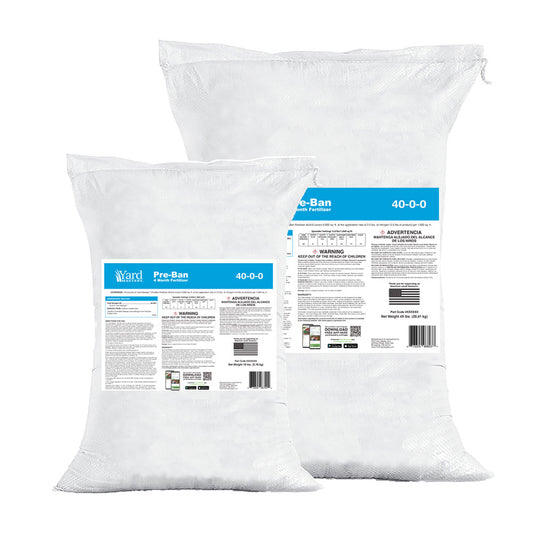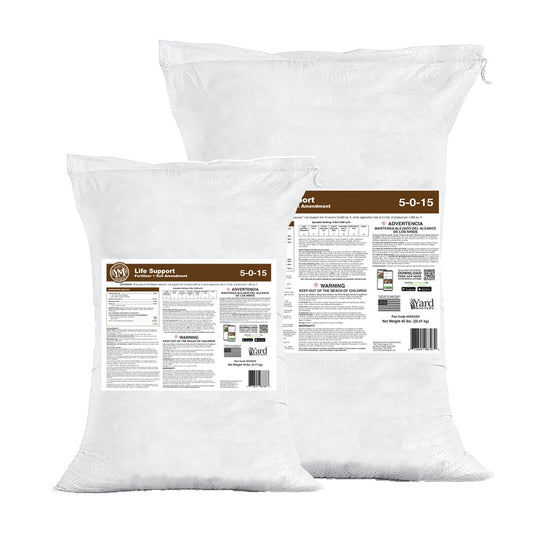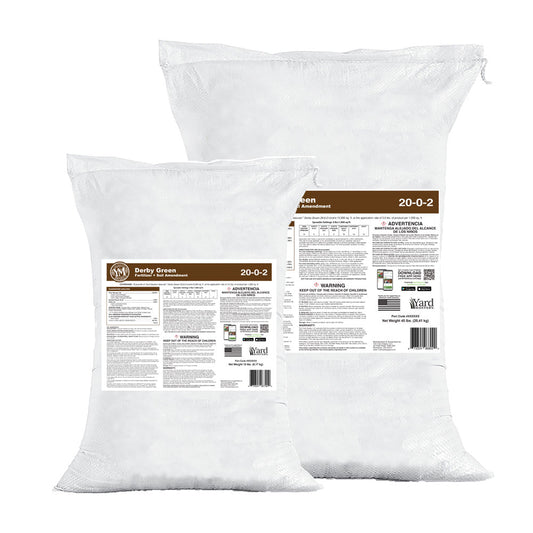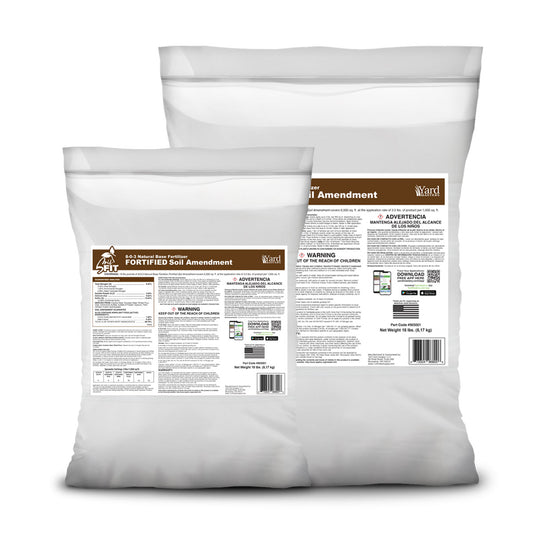What’s up Lawn Care Nuts?
I hope your week is going well and you are seeing some blue skies and sunshine!
This week I am going to talk about fertilizer.
The reason is that I feel there is some confusion about just exactly “what is a fertilizer?” and “how do I know which one to use?”

Now keep in mind, as we go through this, I am talking about primarily lawn fertilizers.
The reason this is important is that a lot of info you find online about fertilizers and fertilization is meant for farmers growing crops.
It’s important for us as “lawn farmers” to not get confused with information meant for guys growing corn or soybeans.
This speaks to the approach. Farmers grow a crop for one year, harvest that crop, and then start over the next year.
So when they apply “fertilizer” to their fields before planting, they are essentially making a “one and done” application that will feed that crop all year from seed germination to full maturity.
And really, they have no choice in the matter - just think about a typical cornfield in the middle of July: you can’t be driving a giant fertilizer spreader through that field unless you plan on stomping down all your corn. So you have to get it all in before anything is growing.
Early in the season, farmers will test their soil, apply the nutrients needed for the year, and then hope for the best. One other thing to note is that the corn plant consumes all those nutrients over the course of the season and then most of that plant taken away at harvest, not returned to the soil.
When we cut our lawns however, we can return 100% of the clippings back to the soil, and our added nutrients can be used again. This is why I recommend mulching your clippings.
Our crop, turfgrass, is much different than farm crops in other ways too. Simply put, it’s always there, year after year. Sure, it goes dormant in the winter and sometimes also in the summer, but it’s still there, making exchanges with the soil, for decades.
So that is the first thing to think about: Fertilizing your lawn is not a “one and done” proposition. It’s an ongoing process of spoon-feeding. Think of fertilizing your lawn like you taking daily vitamins.
Of note: your lawn actually feeds itself - creating its own food via the process of photosynthesis.
Every time the sun comes out, it’s creating sugars to fuel itself. Technically speaking, “fertilizer” is not lawn food, it’s nutrients to support the lawn in making its own food.
What Is Lawn Fertilizer?
The fertilizers we apply are nutrients designed to support the plant in this process.
Kind of like humans taking vitamins and minerals to supplement our own food intake.
Here are the minerals that humans need for optimum health:
Calcium, phosphorus, potassium, sodium, chloride, magnesium, iron, zinc, iodine, sulfur, cobalt, copper, fluoride, manganese, and selenium.
Sometimes you can get these minerals from the food you eat - such as calcium from cheese, potassium from bananas, and sodium from the rim of your margarita.
Other times you may have to take synthetically derived supplements to round out your diet.
Your lawn works in a very similar way.
Here are is what your lawn needs to get from the soil in order to perform optimally:
Nitrogen, phosphorous, potassium, sulfur, calcium, magnesium, sodium, iron, manganese, zinc, copper, boron (there are others but these are the primary).
Do you notice any similarities?
That’s good because when we humans consume plants or animals that have consumed plants, that’s how we obtain many of these for ourselves.
Supplements For Your Lawn
So now that you know what your grass plants need to perform optimally, it’s your job to give them what they cannot get naturally from the soil in your yard, so we throw down fertilizers.
You see, in most cases, soils in residential neighborhoods are lacking in a lot of nutrients.
Sometimes this is because the soil itself is just poorly composed to begin with, and other times, it may be because the lawn has been in place for decades and consumed everything that was there anyway, especially if you bag up your clippings and take them away each week.
This is where the idea of a soil test comes in - to show you what is in your soil.
Here is a video on how to take a soil test, step-by-step in your yard.
You can pick up your own soil test right here.
The double kits are great because you can test your lawn now, throw'er down and then re-test in the Fall to see how your lawn has progressed over the past few months! 
This is a fun project not only for you but for you to do with your kids too.
In an upcoming video I’ll show you how to read and interpret the results but for now, let’s explore some fertilizer basics.
Macronutrients and Micronutrients
A soil test will tell you what is in your soil and what it is lacking, but there is a little more to it than that so let’s next understand what’s in typical lawn fertilizer.
Macronutrients are those that the grass plant needs in the greatest quantities to perform.
The big 3 are Nitrogen (N), Phosphorus (P) and Potassium (K).
When you see 3 numbers on bags of fertilizer, those are representative of these 3 and they are in percentages.
This is a standard - ALL fertilizers will have this analysis on the bag/jug.

Above is pictured from a general-purpose fertilizer found at box stores.
The analysis 16-0-8 stands for N-P-K and tells you that 16% of the bag’s contents are nitrogen and 8% are potassium.
There is no phosphorus in this product.
There are 4 other macronutrients needed in lawns and they are sulfur, calcium, magnesium, and sodium.
If the fertilizer you purchase contains these, it will list them elsewhere on the label in percentages.
Micronutrients are just as important but are needed in much smaller quantities.
Iron, manganese, zinc, copper, and boron are the primary micros we track for lawns. You can see in the photo below this general-purpose fertilizer contains quite a few micros, even ones I don’t typically see, like Molybdenum.
That’s because it’s sold in Florida and the manufacturer, Sunniland, knows these micros are lacking in our soils.

When choosing a fertilizer to apply to your lawn, it will contain some or all of these macros and micros (micros are also referred to as “minors”).
I have a couple of example soil tests that I will break down for you in an upcoming video - be sure to subscribe to The Lawn Care Nut channel if you haven’t already.
General Purpose Fertilizers
If you go to your local big-box store, most of what is there are “general purpose” fertilizers.
Not everyone is going to take a soil test, I know that and so do the major manufacturers of fertilizers so they make products that just work based on general practice.
Kind of like you and me eating a “standard American diet” without having any blood work done.
You know what else?
I can tell you from experience that 95% of professional lawn companies in the United States don’t test soil and they use general-purpose fertilizers and their lawns perform just fine.
However, just like with DIYers, you also have professional “Lawn Care Nuts” who really like to dial in their strategy and maximize results and they do test their customers’ soils.
My friends from Picture Perfect Lawn Maintenance in Dinwiddie, Virginia test every customer’s soil when they first start working with them. This way they give the lawn just what it needs, nothing more and nothing less.
You can see their lawns as a result. Hat’s off to the team at PPLM for making this extra investment in their customers!
However, as I mentioned, most don’t soil test and that’s ok too - if you are a DIYer just starting out, general-purpose fertilizers will do you fine. In fact, that’s what they are made for.
For macronutrient loads (N-P-K), you’ll find general-purpose fertilizers will ALWAYS contain nitrogen.
Nitrogen drives the bus - never forget that. All the other elements you apply are riding on the bus, but Nitrogen is driving it.
If you want your lawn green, nitrogen is what you need upfront and always.
General-purpose fertilizers will also have some potassium in most cases.
As far as phosphorus, you’ll find that less and less in fertilizers off the shelf as many soils across the country already have enough phosphorus in them (phosphorus is banned in some states unless you have a soil test indicates you need it or you are establishing a new lawn).
For micros, most general-purpose fertilizers will have micronutrient iron because it gives the grass a nice blue-green color.
If you are looking for some good general-purpose fertilizers that I recommend, check out these two:
Liquid General Purpose Fertilizer
18-0-1 Greene Punch from Greene County Fertilizer Co.
If you like to apply your fertilizer as a liquid (spraying and praying) then this is the one for you.
Not only does it have excellent sources of nitrogen (N), it also has some potassium (K) and a complement of micronutrient iron to give you some dark blue pop.

I’ve used this fertilizer on my lawn for a couple of years now and it’s awesome!
It’s a great general-purpose fertilizer with a kicker.
And this is where it gets fun: this fertilizer also contains bio-stimulants. Bio-Stimulants are NOT fertilizer but instead are a complement to your fertilizer.
Think of bio-stimulants like drinking a Red Bull but instead of caffeine and Taurine as the kicker, this product contains Humic Acid and Sea Kelp.
Humic Acid is a carbon source, stimulates organisms in the soil, and is known to chelate nutrients - in other words - humic acid assists grassroots in taking up the nutrients you apply.
Coldwater kelp is also a bio-stimulant and its job is to stimulate the plant to make more roots. Those two together are power players.
Sea Kelp to stimulate more roots, and humic acid to help those roots take in the nutrients more efficiently.
Now you see why these are referred to as “Bio-Stimulants?”
Pretty cool right?
It certainly is because now your general purpose fertilizer is juiced and boosted to give you even better performance overall by not only feeding the plant but by feeding the soil along with it.
Note: you will not find fertilizers with bio-stimulants at most big box stores. Pick up 18-0-1 Greene Punch here and note, you get 4 gallons (512 oz) for $108.00 delivered.
This is important to note because these days there are a lot of “made for Amazon” fertilizer brands popping up that charge $40-$50 for a single gallon (128 oz) delivered.
We stay off Amazon so we don’t take on all those fees which means more product to you for the money.
This is another reason why I teach all the math behind this stuff so you can make educated decisions.
Granular General Purpose Fertilizer
24-0-6 Flagship Granular Fertilizer
If you prefer granular fertilizers and want something that is also juiced with kickers (bio-stimulants) then check out Flagship 24-0-6.
It’s got 24% Nitrogen which is a good amount, and also contains 6% potash, no phosphorus.
You will also see micronutrient iron here, just like we find in most general-purpose fertilizers. It also has some managanese, zinc and boron, important for plant health.
But this fert contains something even more - something that will feed microbes in the soil. You see, microorganisms in the soil are actually what break fertilizer down and make it available to plants. If your fert has some goodness riding along that they like, it can stimulate them to be more efficient.
In the case of Flagship, the bio-stimulant is a fill known as "Bio-Nite" which is a natural bio-solid. You have probably heard of the most famous bio-solid fertilizer on the market today known as Milorganite. Bio-Nite is the very same thing as Milorganite but it just comes from a different plant in FLorida instead of the one where Milorganite comes from in Milwaukee.
So not only will the Flagship green up your lawn and supply micronutrients, it will also feed the microbial life in the soil. That's pretty awesome!

If you have been looking at granular fertilizers on Amazon, be sure to look at the size of the bag. This Flagship blend is a 45lb bag and it covers 15,000 sq ft! I point this out because I don't want you to get sticker shocked when you see it. That price includes delivery.
I know from experience that shipping heavy bags via Amazon can be SUPER expensive but when you look at pictures on Amazon all bags look the same size - it’s only when it gets to your house that you realize you paid $35 for a tiny 18 pounder that will barely cover your front yard.
Thanks for reading all the way to the end, I hope you have a great week!
I’ll see you in the lawn!
AL







